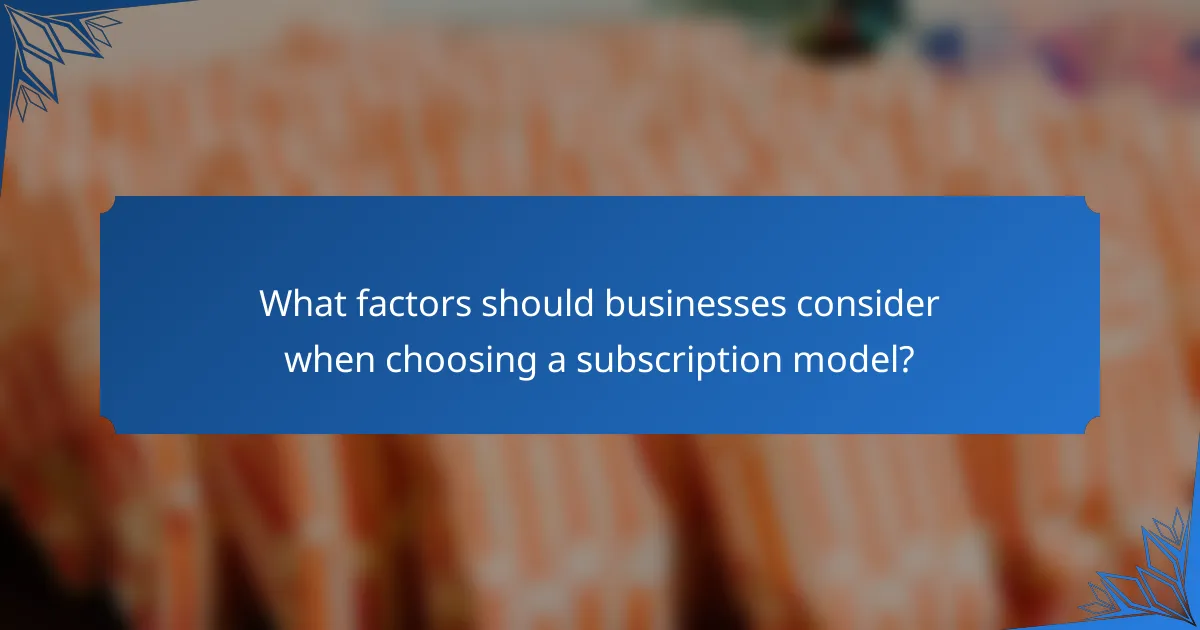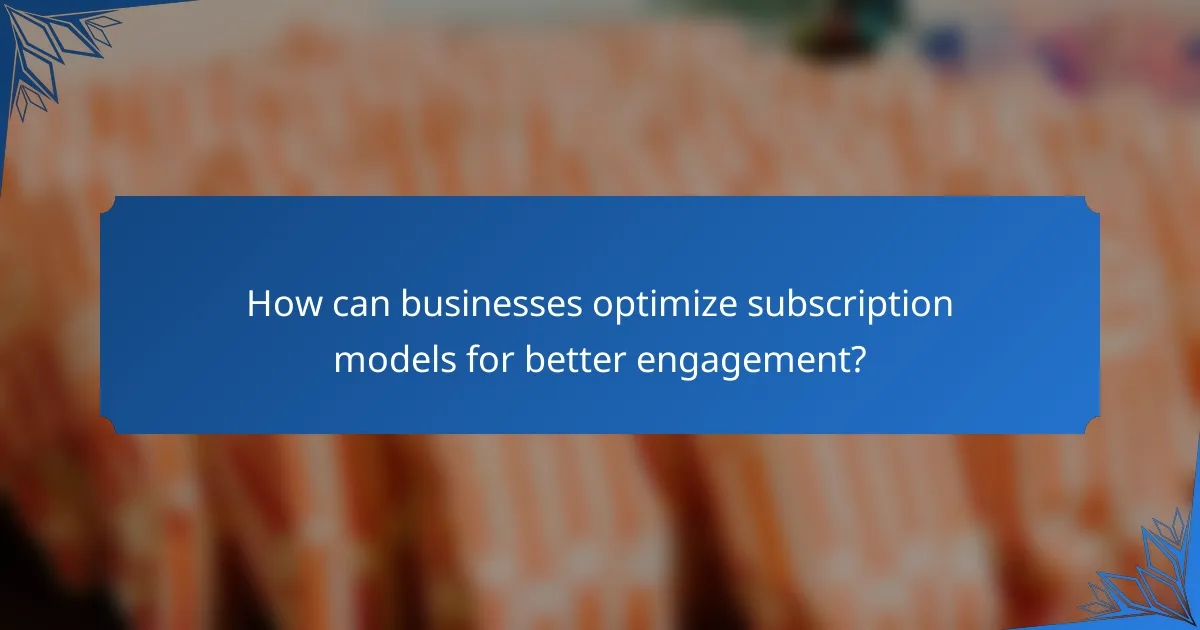Subscription models have become increasingly popular in the gaming industry, offering unique advantages such as enhanced player engagement and consistent revenue streams. By delivering regular updates and exclusive content, these models can foster loyalty and improve player satisfaction. However, they also present challenges, including subscriber fatigue and high churn rates, which can impact both businesses and consumers. Understanding the pros and cons of subscription models is essential for maximizing player engagement and ensuring long-term success.

What are the benefits of subscription models for player engagement?
Subscription models offer several advantages for player engagement, including fostering loyalty, ensuring steady revenue, and enhancing the overall user experience. By providing consistent value through regular updates and exclusive content, these models can significantly improve player retention and satisfaction.
Increased customer loyalty
Subscription models can lead to higher customer loyalty as players feel more invested in a game or service they are paying for regularly. This commitment often translates into longer play sessions and more frequent interactions with the platform.
To cultivate loyalty, companies should focus on delivering quality content and maintaining open lines of communication with subscribers. Regular feedback and updates can help reinforce the relationship and keep players engaged.
Consistent revenue stream
A subscription model provides a predictable revenue stream, allowing developers to plan and allocate resources effectively. This financial stability can lead to improved game development and maintenance, ensuring that players receive ongoing support and new features.
For example, a monthly subscription fee can generate a steady income that helps cover operational costs and fund future expansions or enhancements. This model also reduces reliance on one-time purchases, which can be unpredictable.
Enhanced user experience
With a subscription model, players often enjoy a more tailored and enhanced user experience. Regular updates and new content keep the game fresh and engaging, preventing stagnation.
Additionally, subscribers may receive priority support and access to beta features, further improving their overall experience. This can lead to a more satisfied player base that is likely to recommend the game to others.
Access to exclusive content
Subscription models frequently offer players access to exclusive content that is not available to non-subscribers. This can include special in-game items, early access to new features, or unique gameplay modes.
By providing exclusive content, developers can incentivize players to subscribe while also creating a sense of community among subscribers who share similar experiences and benefits.
Community building opportunities
Subscription models can foster community building among players, as they often create a shared experience. Players who subscribe may engage more with each other through forums, social media, or in-game events.
Developers can enhance this sense of community by organizing exclusive events or competitions for subscribers, encouraging interaction and collaboration among players. This can lead to a more vibrant and active player base, ultimately benefiting the game’s longevity.

What are the drawbacks of subscription models?
Subscription models can lead to several drawbacks that affect both businesses and consumers. Key issues include subscriber fatigue, high churn rates, limited audience reach, and complex pricing structures, all of which can hinder long-term success.
Potential for subscriber fatigue
Subscriber fatigue occurs when consumers feel overwhelmed by the number of subscriptions they hold. As more services emerge, users may struggle to keep track of their subscriptions, leading to dissatisfaction and potential cancellations.
To mitigate this, businesses should focus on delivering consistent value and engaging content. Regularly assessing user preferences and adjusting offerings can help maintain interest and reduce fatigue.
High churn rates
High churn rates refer to the percentage of subscribers who cancel their subscriptions within a given period. This can be particularly challenging for subscription-based businesses, as acquiring new customers often costs significantly more than retaining existing ones.
To combat churn, companies should implement strategies such as personalized communication, loyalty rewards, and regular feedback loops. Understanding why customers leave can provide insights for improvement.
Limited audience reach
Subscription models may limit audience reach, especially if pricing is perceived as too high or if the service is niche. This can restrict growth potential and make it difficult to attract a diverse customer base.
Offering tiered pricing or free trials can help broaden appeal. Additionally, marketing efforts should target specific demographics to maximize engagement and conversion rates.
Complex pricing structures
Complex pricing structures can confuse potential subscribers and deter sign-ups. If customers struggle to understand the value proposition or the differences between tiers, they may abandon the purchase altogether.
To simplify pricing, businesses should aim for transparency and clarity. Clear comparisons of features and benefits across different plans can help customers make informed decisions and feel more confident in their choices.

How do subscription models compare to traditional payment models?
Subscription models provide a steady revenue stream through recurring payments, while traditional payment models rely on one-time purchases. This fundamental difference affects customer engagement, acquisition costs, and access to content.
Recurring payments vs. one-time purchases
Recurring payments in subscription models ensure continuous revenue, allowing businesses to forecast income more accurately. In contrast, one-time purchases generate revenue only at the point of sale, which can lead to fluctuating cash flow.
For example, a streaming service may charge a monthly fee, ensuring consistent income, while a movie rental service earns money only when a customer rents a film. This difference can significantly impact a company’s financial stability and growth potential.
Customer acquisition costs
Customer acquisition costs (CAC) can differ greatly between subscription and traditional models. Subscription services often require higher initial investment to attract customers, as they aim to build a long-term relationship that justifies the upfront cost.
In traditional models, CAC may be lower since the goal is to make a sale rather than foster ongoing engagement. However, the lifetime value of a customer in subscription models can offset these costs, making them more profitable in the long run.
Flexibility in content access
Subscription models typically offer greater flexibility in content access, allowing users to explore a wide range of products or services for a fixed monthly fee. This contrasts with traditional models, where customers pay for each item individually, limiting their options.
For instance, a music streaming service allows subscribers to listen to an extensive library of songs, while purchasing music individually restricts access to only what has been bought. This flexibility can enhance customer satisfaction and retention in subscription-based businesses.

What factors should businesses consider when choosing a subscription model?
Businesses should evaluate several key factors when selecting a subscription model, including their target audience’s preferences, the competitive landscape, and the methods for content delivery. These considerations will help ensure that the chosen model aligns with customer expectations and market demands.
Target audience preferences
Understanding the preferences of your target audience is crucial for selecting an effective subscription model. Conduct surveys or focus groups to gather insights on what customers value, such as pricing, content variety, or flexibility in subscription terms.
For example, younger audiences may prefer lower-cost, flexible options, while older demographics might favor premium services with more comprehensive offerings. Tailoring your subscription model to these preferences can enhance customer satisfaction and retention.
Market competition analysis
Analyzing the competition is essential to identify gaps in the market and differentiate your subscription offering. Research competitors’ pricing structures, features, and customer feedback to understand what works and what doesn’t.
Consider adopting unique selling propositions, such as exclusive content or added services, to stand out. For instance, if competitors offer monthly subscriptions, you might consider an annual plan with a discount to attract long-term customers.
Content delivery methods
The method of content delivery can significantly impact the success of your subscription model. Evaluate whether your audience prefers streaming, downloads, or physical products, as this will influence the logistics and costs associated with your service.
For instance, a digital streaming service may require robust technology infrastructure, while a subscription box service needs efficient shipping processes. Choose a delivery method that aligns with customer expectations and operational capabilities to optimize user experience.

How can businesses optimize subscription models for better engagement?
Businesses can enhance engagement in subscription models by focusing on personalization, offering incentives for long-term commitments, and providing regular content updates. These strategies help create a more tailored experience for subscribers, fostering loyalty and reducing churn.
Personalization strategies
Personalization involves tailoring the subscription experience to individual user preferences and behaviors. This can include customized content recommendations, targeted email campaigns, and user-specific pricing options. By analyzing subscriber data, businesses can identify trends and preferences, allowing for a more engaging experience.
For example, streaming services often use algorithms to suggest shows or movies based on viewing history. Implementing similar strategies can significantly increase user satisfaction and retention.
Incentives for long-term subscriptions
Offering incentives for long-term subscriptions can encourage users to commit for extended periods. Common strategies include discounts for annual plans, exclusive content access, or loyalty rewards. These incentives not only enhance perceived value but also stabilize revenue streams.
Businesses should consider tiered pricing models where subscribers receive additional benefits at different commitment levels. For instance, a fitness app might offer a lower monthly rate for a six-month subscription compared to a month-to-month plan.
Regular content updates
Consistently updating content is crucial for maintaining subscriber interest and engagement. This can involve adding new features, refreshing existing content, or introducing seasonal offerings. Regular updates keep the service dynamic and encourage users to return frequently.
For instance, a news subscription service might provide daily updates on current events, while a gaming platform could release new titles or expansions regularly. Establishing a predictable schedule for updates can further enhance user anticipation and satisfaction.



